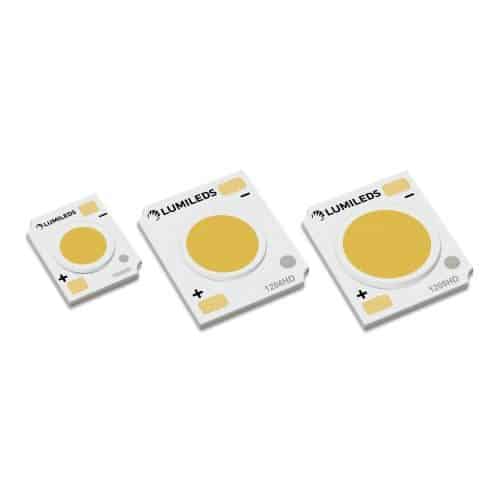A CoB LED (or chip-on-board LED) is a single device with many LED chips mounted on a thermally efficient substrate placed below a uniform phosphor coating.
Anyone who walks through a store or home with recessed or track lighting likely experiences light from a chip-on-board LED (CoB). CoBs are widely used because they emit a bright white light output from a compact light source and are very efficient in a broad range of applications.
So what is a CoB LED, and how is it different from other types of LEDs?
CoB (chip-on-board) refers to the way in which the LED unit is constructed. The basic elements of white CoB LEDs are:

A CoB LED is a single device with many LED chips mounted on a thermally efficient substrate, or board. Each chip is a bare die – that is, the chip does not have its own leadframe, phosphor coating or lens. This means that the chips can be mounted extremely closely together on the substrate. The close placement of the LED chips allows for high intensity or light density to be emitted from a smaller area than is possible with single packaged LEDs. The CoB LED manufacturer then applies a uniform phosphor coating to the entire array of chips to convert the blue light to the required white color temperature.

A single CoB LED can contain hundreds of chips forming a dense array. This dense array enables a CoB LED to produce more light output from a smaller area than is generally possible with an array of packaged LEDs.
Using a single LED can result in simpler design and product as well as providing optical advantages for uniform light and efficient optics.
Electrical design is simpler because the CoB LED only requires a single two-wire power supply to the entire array of chips. The positive and negative terminals on a CoB LED are clearly visible in the picture of LUXEON CoB Core Range products above. By contrast, an array of packaged LEDs requires dedicated power supply traces to be routed on the PCB to each LED unit.
Production is simpler because the number of units to be soldered to the board will be lower if a CoB LED is used instead of an array of packaged LEDs.
Optically, a broad range of optics, usually reflectors, can be used with CoBs of different sizes to determine the direction and width of the beam such as with a spot or flood lamp.
Finally, a CoB LED’s color is potentially more consistent because a single phosphor coating is applied to the entire array of chips, whereas in an array of packaged LEDs, each LED unit has its own phosphor coating.
An example of CoB LEDs of various sizes is shown below.

Lumileds supplies a comprehensive range of CoB LEDs for general lighting, as well as CoB LED products optimized for retail and hospitality lighting. More information can be found at lumileds.com/products/cob-leds/.